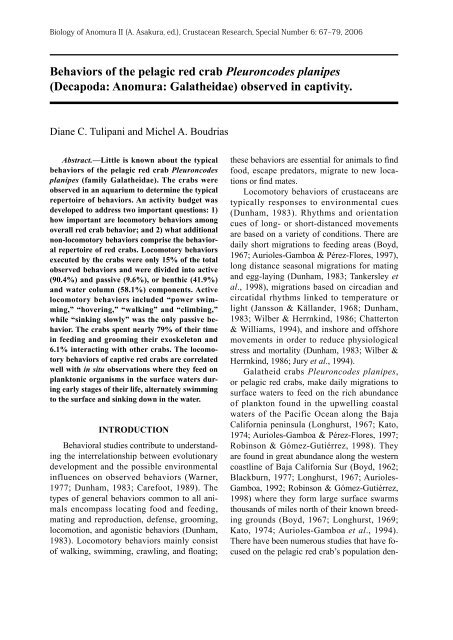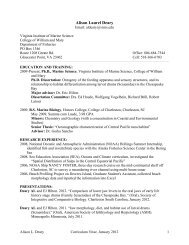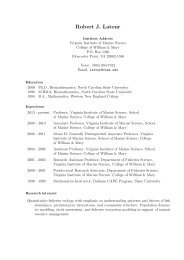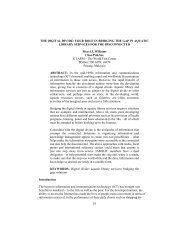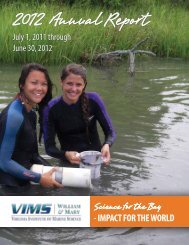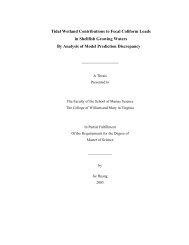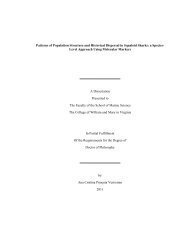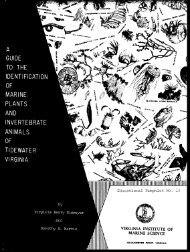Behaviors of the pelagic red crab Pleuroncodes planipes observed ...
Behaviors of the pelagic red crab Pleuroncodes planipes observed ...
Behaviors of the pelagic red crab Pleuroncodes planipes observed ...
Create successful ePaper yourself
Turn your PDF publications into a flip-book with our unique Google optimized e-Paper software.
<strong>Behaviors</strong> <strong>of</strong> <strong>the</strong> <strong>pelagic</strong> <strong>red</strong> <strong>crab</strong> <strong>Pleuroncodes</strong> <strong>planipes</strong>(Decapoda: Anomura: Gala<strong>the</strong>idae) <strong>observed</strong> in captivity.Diane C. Tulipani and Michel A. BoudriasAbstract.—Little is known about <strong>the</strong> typicalbehaviors <strong>of</strong> <strong>the</strong> <strong>pelagic</strong> <strong>red</strong> <strong>crab</strong> <strong>Pleuroncodes</strong><strong>planipes</strong> (family Gala<strong>the</strong>idae). The <strong>crab</strong>s were<strong>observed</strong> in an aquarium to determine <strong>the</strong> typicalrepertoire <strong>of</strong> behaviors. An activity budget wasdeveloped to address two important questions: 1)how important are locomotory behaviors amongoverall <strong>red</strong> <strong>crab</strong> behavior; and 2) what additionalnon-locomotory behaviors comprise <strong>the</strong> behavioralrepertoire <strong>of</strong> <strong>red</strong> <strong>crab</strong>s. Locomotory behaviorsexecuted by <strong>the</strong> <strong>crab</strong>s were only 15% <strong>of</strong> <strong>the</strong> total<strong>observed</strong> behaviors and were divided into active(90.4%) and passive (9.6%), or benthic (41.9%)and water column (58.1%) components. Activelocomotory behaviors included “power swimming,”“hovering,” “walking” and “climbing,”while “sinking slowly” was <strong>the</strong> only passive behavior.The <strong>crab</strong>s spent nearly 79% <strong>of</strong> <strong>the</strong>ir timein feeding and grooming <strong>the</strong>ir exoskeleton and6.1% interacting with o<strong>the</strong>r <strong>crab</strong>s. The locomotorybehaviors <strong>of</strong> captive <strong>red</strong> <strong>crab</strong>s are correlatedwell with in situ observations where <strong>the</strong>y feed onplanktonic organisms in <strong>the</strong> surface waters duringearly stages <strong>of</strong> <strong>the</strong>ir life, alternately swimmingto <strong>the</strong> surface and sinking down in <strong>the</strong> water.INTRODUCTIONBehavioral studies contribute to understanding<strong>the</strong> interrelationship between evolutionarydevelopment and <strong>the</strong> possible environmentalinfluences on <strong>observed</strong> behaviors (Warner,1977; Dunham, 1983; Carefoot, 1989). Thetypes <strong>of</strong> general behaviors common to all animalsencompass locating food and feeding,mating and reproduction, defense, grooming,locomotion, and agonistic behaviors (Dunham,1983). Locomotory behaviors mainly consist<strong>of</strong> walking, swimming, crawling, and floating;<strong>the</strong>se behaviors are essential for animals to findfood, escape p<strong>red</strong>ators, migrate to new locationsor find mates.Locomotory behaviors <strong>of</strong> crustaceans aretypically responses to environmental cues(Dunham, 1983). Rhythms and orientationcues <strong>of</strong> long- or short-distanced movementsare based on a variety <strong>of</strong> conditions. There a<strong>red</strong>aily short migrations to feeding areas (Boyd,1967; Aurioles-Gamboa & Pérez-Flores, 1997),long distance seasonal migrations for matingand egg-laying (Dunham, 1983; Tankersley etal., 1998), migrations based on circadian andcircatidal rhythms linked to temperature orlight (Jansson & Källander, 1968; Dunham,1983; Wilber & Herrnkind, 1986; Chatterton& Williams, 1994), and inshore and <strong>of</strong>fshoremovements in order to <strong>red</strong>uce physiologicalstress and mortality (Dunham, 1983; Wilber &Herrnkind, 1986; Jury et al., 1994).Gala<strong>the</strong>id <strong>crab</strong>s <strong>Pleuroncodes</strong> <strong>planipes</strong>,or <strong>pelagic</strong> <strong>red</strong> <strong>crab</strong>s, make daily migrations tosurface waters to feed on <strong>the</strong> rich abundance<strong>of</strong> plankton found in <strong>the</strong> upwelling coastalwaters <strong>of</strong> <strong>the</strong> Pacific Ocean along <strong>the</strong> BajaCalifornia peninsula (Longhurst, 1967; Kato,1974; Aurioles-Gamboa & Pérez-Flores, 1997;Robinson & Gómez-Gutiérrez, 1998). Theyare found in great abundance along <strong>the</strong> westerncoastline <strong>of</strong> Baja California Sur (Boyd, 1962;Blackburn, 1977; Longhurst, 1967; Aurioles-Gamboa, 1992; Robinson & Gómez-Gutiérrez,1998) where <strong>the</strong>y form large surface swarmsthousands <strong>of</strong> miles north <strong>of</strong> <strong>the</strong>ir known breedinggrounds (Boyd, 1967; Longhurst, 1969;Kato, 1974; Aurioles-Gamboa et al., 1994).There have been numerous studies that have focusedon <strong>the</strong> <strong>pelagic</strong> <strong>red</strong> <strong>crab</strong>’s population den-
68 D. C. Tulipani & M. A. Boudriassity (Boyd, 1962; Longhurst, 1967; Aurioles-Gamboa & Pérez-Flores, 1997), its ecologicalrole in <strong>the</strong> Baja California peninsula coastalwaters and its viability as a productive fishery(Longhurst, 1967; Kato, 1974; Robinson &Gómez-Gutiérrez, 1998).However, little is known about <strong>the</strong> typicalbehaviors <strong>of</strong> P. <strong>planipes</strong>. Kato (1974)briefly described how <strong>the</strong>y swim to <strong>the</strong> surface,change posture to a parachute-shaped pose,and <strong>the</strong>n feed while slowly sinking. This briefdescription leaves some important questionsunanswe<strong>red</strong>: 1) how important are locomotorybehaviors to overall <strong>red</strong> <strong>crab</strong> behavior; and 2)what additional non-locomotory behaviors comprise<strong>the</strong> behavioral repertoire <strong>of</strong> <strong>the</strong> <strong>red</strong> <strong>crab</strong>s?In this study, <strong>the</strong> <strong>red</strong> <strong>crab</strong>s were <strong>observed</strong> in anaquarium to determine <strong>the</strong> typical repertoire <strong>of</strong>behaviors and to develop an activity budget forall locomotory and non-locomotory behaviorsas part <strong>of</strong> an on-going larger study <strong>of</strong> locomotionin this species (Tulipani, 2005).MATERIALS AND METHODSGeneral procedure<strong>Pleuroncodes</strong> <strong>planipes</strong> in captivity wereunder frequent, but not continuous, personalobservation each day. Total observation timefrom June 2001 to September 2003 was approximately800 hours. At any given time overthis period, <strong>the</strong>re were a varying number <strong>of</strong> <strong>red</strong><strong>crab</strong>s, from a few up to 100, in an aquariumat <strong>the</strong> University <strong>of</strong> San Diego. The <strong>crab</strong>s incaptivity were videotaped and photographed atvarious times during <strong>the</strong> study period in support<strong>of</strong> behavior, kinematic, fluid dynamic, andlocomotory behaviors analyses.Specimen collection and careIn June 2001, <strong>the</strong> first group <strong>of</strong> approximately90 P. <strong>planipes</strong> was collected, using alarge dip net, from <strong>the</strong> surface waters at <strong>the</strong>mouth <strong>of</strong> Bahía Magdalena (24º32.89’ N and112º02.63’ W) on <strong>the</strong> southwestern coast <strong>of</strong> <strong>the</strong>Baja California peninsula in Baja CaliforniaSur, Mexico. Fifteen <strong>crab</strong>s were transportedlive to <strong>the</strong> University <strong>of</strong> San Diego via automobile.Ano<strong>the</strong>r group <strong>of</strong> approximately 100<strong>crab</strong>s was collected from various San Diego,California beaches during multiple strandingevents that occur<strong>red</strong> over <strong>the</strong> course <strong>of</strong> nearlythree weeks from <strong>the</strong> end <strong>of</strong> April to early May2002.The <strong>crab</strong>s were kept at <strong>the</strong> University <strong>of</strong> SanDiego in a 250-gallon aquarium with a recirculatingfiltration and cooling system under <strong>the</strong>cycle <strong>of</strong> light (07:00 to 21:00) and dark (21:00to 07:00) periods. In addition to daytime observations,<strong>the</strong> <strong>crab</strong>s were <strong>observed</strong> with <strong>the</strong> aid<strong>of</strong> a flashlight at various times during <strong>the</strong> darkphotoperiod. The retention area <strong>of</strong> <strong>the</strong> aquariumwas approximately 2.5 m (x-axis) long and 66cm wide (y-axis) with <strong>the</strong> water depth (z-axis)approximately 1 m. The water temperature wasmaintained between 15–18ºC. The <strong>crab</strong>s werefed squid once a day and supplemented withphytoplankton and pellet food, with all uneatenfood removed after several hours.Activity budgetFor <strong>the</strong> purpose <strong>of</strong> developing a “typical “or “average” activity budget for <strong>the</strong> <strong>red</strong> <strong>crab</strong>s incaptivity, undisturbed activities <strong>of</strong> a total <strong>of</strong> 30randomly chosen <strong>crab</strong>s were videotaped for 15minutes per <strong>crab</strong>, five <strong>crab</strong>s on each <strong>of</strong> six differentoccasions on 23 May, and 8, 12, 20, 22,and 25 June 2002. Using a 8 mm video cameramodel RCA Pro842 attached to a tripod, behaviorswere recorded twice during morning hours(8:00 am–10:00 am Pacific Daylight-savingsTime (PDT), on 8 and 25 June 2002), twiceduring afternoon hours (1:30 pm–4:30 pm PDT,on 20 and 22 June 2002), and twice duringevening hours (6:00 pm–8:30 pm PDT, on 23May and 12 June 2002). The tapes were eachviewed twice, once to categorize <strong>the</strong> behaviorsand secondly to count <strong>the</strong> number <strong>of</strong> times eachbehavior occur<strong>red</strong>.The behaviors were grouped into two broadcategories: locomotory and stationary, and<strong>the</strong>se were fur<strong>the</strong>r broken into subcategoriesthat were more descriptive. Locomotory behaviorwas defined as that conducted when a <strong>crab</strong>moved from one place to ano<strong>the</strong>r and included:1) swimming (using tail-flips for propulsion)
<strong>Behaviors</strong> <strong>of</strong> <strong>Pleuroncodes</strong> <strong>planipes</strong> 69Fig. 1. Illustration <strong>of</strong> swimming bout by <strong>Pleuroncodes</strong> <strong>planipes</strong>: A) launch from bottom, B) tail-flipswimming, C) breach surface <strong>of</strong> water, D) sink, E) landing on side wall. Illustration by D. Tulipani.(Fig. 1A–C), 2) sinking (Fig. 1D), 3) surfaceswimming pattern (whereby <strong>the</strong> <strong>crab</strong> stays near<strong>the</strong> water’s surface to feed) (Fig. 2A), 4) hovering(<strong>crab</strong> maintains vertical position within <strong>the</strong>water column by using several abbreviated tailflips)(Fig. 2B), 5) walking (Fig. 2D), and 6)climbing (Fig. 2C).Stationary behavior defined as <strong>the</strong> <strong>crab</strong>standing relatively still on a surface was dividedinto three subcategories: 1) interactions withano<strong>the</strong>r <strong>crab</strong>, included a) pushing, b) bumping,c) landing on (Fig. 2F), d) sparring (Fig. 2E),e) tail-flick, and f) antenna flick; 2) “groomingbehavior” was based on which body part wasbeing cleaned and usually entailed <strong>the</strong> scrubbing,rubbing, or wiping <strong>of</strong> <strong>the</strong>se various bodyparts with one (or both) <strong>of</strong> <strong>the</strong> two modifiedfifth pereopods, wiping an eye with both maxillipeds,or by dragging an antenna between <strong>the</strong>maxillipeds; 3) “feeding behavior” was basedon <strong>the</strong> appendage by which food was captu<strong>red</strong>and transfer<strong>red</strong> to <strong>the</strong> mouth region. The abovementionedsubcategories 2) and 3) had mo<strong>red</strong>etailed components based only on <strong>the</strong> greatervariety <strong>of</strong> modes <strong>of</strong> collecting food and areas <strong>of</strong>grooming.Each occurrence <strong>of</strong> behaviors was tallied ona datasheet during <strong>the</strong> 15-minute observationtime for each <strong>crab</strong>. The tallies for each behaviorwere totaled and summarized. Terminology and
70 D. C. Tulipani & M. A. BoudriasFig. 2. Illustration <strong>of</strong> various locomotory and stationary behaviors by <strong>Pleuroncodes</strong> <strong>planipes</strong>: A) surfaceswimming pattern, B) hovering, C) climbing, D) walking, E) sparring, F) landing on. Illustration by D.Tulipani.function described by Bauer (1989) were followedfor <strong>the</strong> fifth pereopods.Analysis <strong>of</strong> active swimming and passivesinking sequencesOn 13 and 14 September 2001, <strong>the</strong> swimmingactivity <strong>of</strong> four <strong>crab</strong>s in <strong>the</strong> aquarium wasvideotaped for two hours each day, using bothan RCA Pro842 8mm and a Panasonic VHS-CPalmcorder IQ model PV-IQ405D video cameras,one attached to a tripod and <strong>the</strong> o<strong>the</strong>rhandheld. Prior to videotaping, a laminatedgrid (2.54 cm x 2.54 cm squares) was attachedto <strong>the</strong> back <strong>of</strong> <strong>the</strong> aquarium to provide a scale<strong>of</strong> horizontal and vertical linear distance. Thevideos were <strong>the</strong>n viewed on a Sony DA Pro4-head VCR, Model SLV-373UC, with stopframecapabilities. Individual swimming boutswere identified for each <strong>crab</strong> and <strong>the</strong> <strong>crab</strong>’s vertical,horizontal and diagonal movements wererecorded, with particular note <strong>of</strong> ‘power swim’segments and passive sinking segments <strong>of</strong> eachbout. The elapsed duration <strong>of</strong> each swimmingbout was calculated based on <strong>the</strong> start and endtimes recorded while reviewing <strong>the</strong> videotapes.RESULTSGeneral behavioral observationsAll <strong>of</strong> <strong>the</strong> captive <strong>Pleuroncodes</strong> <strong>planipes</strong>routinely <strong>observed</strong> throughout <strong>the</strong>ir captivitywere active at all times <strong>of</strong> <strong>the</strong> day and night.
<strong>Behaviors</strong> <strong>of</strong> <strong>Pleuroncodes</strong> <strong>planipes</strong> 71Fig. 3. Activity budget <strong>of</strong> <strong>Pleuroncodes</strong> <strong>planipes</strong>. Percentage <strong>of</strong> total activities spent on stationary (feeding,grooming, and interactions with o<strong>the</strong>r <strong>crab</strong>s) and locomotory behaviors.Although many <strong>of</strong> <strong>the</strong> <strong>crab</strong>s were captu<strong>red</strong>swimming in surface waters, all quickly settledto a mostly benthic lifestyle when introduced to<strong>the</strong> aquarium. Common behaviors <strong>of</strong> decapods,such as swimming, climbing, feeding, grooming,molting, and interacting with each o<strong>the</strong>r,were noted at all times during both light anddark photoperiods. When food items, like cutsquid, were dropped into <strong>the</strong> aquarium, activefeeding was <strong>observed</strong>, sometimes with aggressiveinteractions between <strong>crab</strong>s over pieces <strong>of</strong>food. Crabs would catch, hold, and sometimestear pieces <strong>of</strong> food with <strong>the</strong>ir chelipeds whileeating it.Activity budgetAll <strong>of</strong> <strong>the</strong> behaviors <strong>observed</strong> throughout<strong>the</strong> period <strong>of</strong> captivity were performed by all <strong>of</strong><strong>the</strong> <strong>red</strong> <strong>crab</strong>s. Based on <strong>the</strong> videotaped observations,captive <strong>red</strong> <strong>crab</strong>s spent 85% <strong>of</strong> <strong>the</strong>ir totalactivities performing stationary behaviors (Fig.3). Of <strong>the</strong> stationary behaviors, <strong>the</strong> majority<strong>of</strong> <strong>the</strong>ir activity was feeding behaviors, whichaccounted for 66.4% <strong>of</strong> all <strong>observed</strong> activitieswhere <strong>the</strong> <strong>crab</strong>s performed any <strong>of</strong> <strong>the</strong> five feeding-relatedactivities. Grooming as a whole was12.5% <strong>of</strong> <strong>the</strong> behaviors (Fig. 3). Interactionswith o<strong>the</strong>r <strong>crab</strong> were 6.1% <strong>of</strong> all behaviors (Fig.3).Locomotory behaviors accounted for 15%<strong>of</strong> <strong>the</strong> total <strong>crab</strong>s’ <strong>observed</strong> activities (Fig.3) which included walking (35.7%), surfaceswimming (23.5%), power swimming (16.2%),sinking (9.6%), hovering (8.8%) or climbing(6.2%) (Table 1). These six behaviors werefur<strong>the</strong>r categorized as active or passive movement(Table 1), but only sinking (comprising9.6% <strong>of</strong> locomotory behaviors) was conside<strong>red</strong>a passive locomotory behavior, as a <strong>crab</strong> didnot actively move any <strong>of</strong> its appendages whileit sank. Of all locomotory behaviors, 90.4%were active, with <strong>the</strong> <strong>crab</strong> using its appendagesto move in <strong>the</strong> water column or on a surfacewithin <strong>the</strong> aquarium (Table 1).The locomotory behaviors were fur<strong>the</strong>rcategorized into water column or benthic for<strong>the</strong> captive <strong>crab</strong>s (Table 1) which is reflective<strong>of</strong> reported in situ behaviors <strong>of</strong> <strong>red</strong> <strong>crab</strong>s. Watercolumn behaviors (swimming, sinking, surfaceswimming, and hovering) accounted for 58.1%
72 D. C. Tulipani & M. A. BoudriasTable 1. Activity budget <strong>of</strong> <strong>Pleuroncodes</strong> <strong>planipes</strong>.Detail <strong>of</strong> locomotory behaviors. See text fordefinition <strong>of</strong> each behavior.Locomotory behaviors (15%)Active PassiveWater Column:Surface Swimming 23.5%Swimming 16.2%Sinking 9.6%Hovering 8.8%Subtotal 48.5% 9.6% 58.1%Benthic:Walking 35.7%Climbing 6.2%Subtotal 41.9% 0.0% 41.9%Total 90.4% 9.6% 100.0%<strong>of</strong> all locomotory behaviors, while benthicbehaviors (climbing and walking) comprised<strong>the</strong> o<strong>the</strong>r 41.9% (Table 1).Therefore, <strong>the</strong> <strong>crab</strong>sspent <strong>the</strong> majority <strong>of</strong> <strong>the</strong> locomotory time activelymoving around in <strong>the</strong> water column.Locomotory behaviorA swimming bout was a finite event thatbegan once a <strong>crab</strong> launched itself from a surfacein <strong>the</strong> aquarium and ended when <strong>the</strong> <strong>crab</strong>landed on some o<strong>the</strong>r surface in <strong>the</strong> aquarium(Fig. 1). For example, a complete swimmingbout could start with a <strong>crab</strong> hanging head downfrom one <strong>of</strong> <strong>the</strong> side walls <strong>of</strong> <strong>the</strong> aquarium, <strong>the</strong>nlaunching itself away from <strong>the</strong> wall, performingseveral tail-flips, alternatively sinking andtail-flip swimming, until landing on <strong>the</strong> bottom.A ‘power swim’ segment was defined as a portion<strong>of</strong> a swimming bout when a <strong>crab</strong> rapidlymoved in a curved or straight path using manyconsecutive tail-flips without stopping until itreached <strong>the</strong> surface <strong>of</strong> <strong>the</strong> water, a side wall, orperformed ano<strong>the</strong>r maneuver (Fig. 1B).Swimming consisted <strong>of</strong> propulsive tail-flipsexecuted with <strong>the</strong> abdomen and tail fan while<strong>the</strong> <strong>crab</strong> adopted a streamlined swimming position,moving around in <strong>the</strong> water column. Atail-flip consisted <strong>of</strong> five sequentially occurringmovements that, when combined, generated<strong>the</strong> propulsive force that moved a <strong>crab</strong> rapidlyin a posterior and dorsal direction (Fig. 4A–D). First, a tail-flip started from <strong>the</strong> positionwhere <strong>the</strong> abdomen was contracted and <strong>the</strong> tailfan was flat against <strong>the</strong> thoracic plate (Fig. 4A).Second, <strong>the</strong>re was an extension <strong>of</strong> <strong>the</strong> abdomenand tail fan posteriorly (Fig. 4B). Third,when <strong>the</strong> abdomen was at its maximum extension,<strong>the</strong> tail fan was extended perpendicular to<strong>the</strong> abdomen at <strong>the</strong> fourth abdominal segmentwith a simultaneous abduction <strong>of</strong> <strong>the</strong> uropods(Fig. 4C). Fourth, this was followed by a rapidcontraction <strong>of</strong> <strong>the</strong> abdomen with <strong>the</strong> telson anduropods still expanded (Fig. 4D). Fifth, <strong>the</strong> tailflipended with a contraction <strong>of</strong> <strong>the</strong> abdominalmuscle to press <strong>the</strong> retracted tail fan against<strong>the</strong> thoracic plate <strong>of</strong> <strong>the</strong> <strong>crab</strong> producing a jet <strong>of</strong>water that propelled <strong>the</strong> <strong>crab</strong> posteriorly anddorsally. This final position was <strong>the</strong> same as <strong>the</strong>first and completed <strong>the</strong> tail-flip propulsion (Fig.4A).During some swimming bouts, <strong>crab</strong>s couldhover in mid-water by using several tail-flickswhere <strong>the</strong> abducted tail fan beat against <strong>the</strong>abdomen without <strong>the</strong> full abduction-adductioncycle <strong>of</strong> <strong>the</strong> uropods (Fig. 2B). In this case,<strong>the</strong> <strong>crab</strong> positioned its body with its rostrumpointing to <strong>the</strong> bottom <strong>of</strong> <strong>the</strong> aquarium, <strong>the</strong>curved dorsal edge <strong>of</strong> its abdomen pointingto <strong>the</strong> water’s surface, and all <strong>of</strong> thoracic legswere extended away from <strong>the</strong> body; once inthis posture, it executed numerous tail-flicks.This particular motion did not create a full jet<strong>of</strong> water like that in tail-flip swimming. Thus<strong>the</strong> <strong>crab</strong> maintained its relative vertical positionin <strong>the</strong> water column with this sequence <strong>of</strong>movements. While hovering, <strong>crab</strong>s sometimesdrifted horizontally due to <strong>the</strong> water flow in <strong>the</strong>aquarium.Passive sinking segments were identifiedeasily when a <strong>crab</strong> splayed out all <strong>of</strong> its legs,extending <strong>the</strong>m so that none were touching, andslowly sank without moving any appendages.The general body shape in <strong>the</strong> passive sinkingposture was similar to <strong>the</strong> shape <strong>of</strong> an openedparachute, and <strong>the</strong> setae that line <strong>the</strong> pereopodsand chelipeds passively extended away fromboth <strong>the</strong> medial and lateral edges <strong>of</strong> all limbs tobe perpendicular to <strong>the</strong> limb (Tulipani, 2005).
<strong>Behaviors</strong> <strong>of</strong> <strong>Pleuroncodes</strong> <strong>planipes</strong> 73Fig. 4. <strong>Pleuroncodes</strong> <strong>planipes</strong> in swimming posture, ventral view (left) and left lateral view (right), withabdomen and tail in: A) 1st position <strong>of</strong> tail-flip, B) 2nd position <strong>of</strong> tail-flip, C) 3rd position <strong>of</strong> tail-flip, D) 4thposition <strong>of</strong> tail-flip. Illustration by V. Ruiz.Passive sinking continued until <strong>the</strong> <strong>crab</strong> landedon <strong>the</strong> bottom or side wall, hove<strong>red</strong>, or performedano<strong>the</strong>r series <strong>of</strong> tail-flips to move toano<strong>the</strong>r location in <strong>the</strong> aquarium.Using pereopod pairs 2, 3, and 4, <strong>red</strong> <strong>crab</strong>swalked or climbed in any direction (anteriorly,posteriorly, or laterally), over <strong>the</strong> rocks andplastic tubing on <strong>the</strong> bottom <strong>of</strong> <strong>the</strong> aquarium,holding <strong>the</strong>ir two chelipeds extended anteriorlyand elevated from <strong>the</strong> bottom’s surface (Fig. 2).The plastic grating lining <strong>the</strong> side walls enabled<strong>the</strong> <strong>crab</strong>s to climb to <strong>the</strong> top <strong>of</strong> <strong>the</strong> aquarium,stopping just below <strong>the</strong> water’s surface (Fig. 2).Stationary behaviorsWhen stationary, <strong>red</strong> <strong>crab</strong>s stood with <strong>the</strong>ircheliped tips touching <strong>the</strong> surface <strong>the</strong>y were on.Grooming behaviors appea<strong>red</strong> to concentrateon setal maintenance whereby a <strong>crab</strong> kept <strong>the</strong>setae on <strong>the</strong> carapace and pereopods free fromvisible fouling particles. Using <strong>the</strong> distal end(propodus and dactylus) <strong>of</strong> one or both chelatefifth pereopods, which are cove<strong>red</strong> with sickleshapedsetae (Fig. 5), <strong>crab</strong>s wiped, rubbed, orscrubbed <strong>the</strong>ir pereopod in <strong>the</strong> same directionas <strong>the</strong> orientation <strong>of</strong> <strong>the</strong> body setae. Crabsused <strong>the</strong> cleaner pereopod to clean <strong>the</strong> entire
74 D. C. Tulipani & M. A. BoudriasFig. 5. Fifth pereopod <strong>of</strong> <strong>Pleuroncodes</strong> <strong>planipes</strong>. 1)Scanning electron micrograph <strong>of</strong> <strong>the</strong> distal end <strong>of</strong><strong>the</strong> chelate 5th right pereopod. The limbs are usedmainly clean <strong>the</strong> exoskeleton and setae. Females uselimbs to stir <strong>the</strong> fertilized eggs after mating. 2) Rightlateral view <strong>of</strong> posterior body showing 5th pereopodtucked along <strong>the</strong> side <strong>of</strong> <strong>the</strong> carapace (black arrow).Scale: 1 block = 2 mm.body surface as well. A <strong>crab</strong> would sometimesscrub <strong>the</strong> tip <strong>of</strong> <strong>the</strong> cleaner pereopod againsta groove in its exoskeleton to loosen particlestrapped by <strong>the</strong> setae. Crabs folded <strong>the</strong>ir chelipedsmedially and posteriorly, enabling <strong>the</strong>cleaner pereopod to reach <strong>the</strong> entirety <strong>of</strong> <strong>the</strong>selimbs. Additionally, <strong>crab</strong>s used <strong>the</strong>ir maxillipedsto wipe <strong>the</strong> end <strong>of</strong> <strong>the</strong> cleaning pereopods,<strong>the</strong>ir antennae and <strong>the</strong>ir eyes. When groomingstopped, <strong>crab</strong>s typically folded and partiallytucked <strong>the</strong> distal ends <strong>of</strong> <strong>the</strong> fifth pereopodsunder <strong>the</strong> lateral posterior edge <strong>of</strong> <strong>the</strong> carapace(Fig. 5).Frequently, grooming behavior was immediatelyfollowed by feeding behavior where<strong>Pleuroncodes</strong> <strong>planipes</strong> would use <strong>the</strong>ir maxillipedsto wipe <strong>of</strong>f <strong>the</strong> tip <strong>of</strong> <strong>the</strong> fifth pereopod,which was immediately followed by <strong>the</strong> anterior-posteriormovement <strong>of</strong> <strong>the</strong> mandibular palps.The movement <strong>of</strong> <strong>the</strong> maxillipeds towards <strong>the</strong>mouth region appea<strong>red</strong> to transfer particles to<strong>the</strong> mouth. The mandibular palps would waverapidly towards and away from <strong>the</strong> mouth tomove <strong>the</strong> particles into <strong>the</strong> mouth. In addition,captive <strong>red</strong> <strong>crab</strong>s were <strong>observed</strong> feeding,independent <strong>of</strong> grooming, while standing on<strong>the</strong> bottom <strong>of</strong> <strong>the</strong> aquarium or hanging from aside wall. With <strong>the</strong> rostral spine tilted slightlyupwards, <strong>crab</strong>s would extend and retract <strong>the</strong>irmaxillipeds away from and <strong>the</strong>n towards <strong>the</strong>irmouth region generating water movement(visible as <strong>the</strong> movement <strong>of</strong> food particles)towards <strong>the</strong>ir mouth while intermittently oscillating<strong>the</strong>ir mandibular palps. Occasionally,<strong>red</strong> <strong>crab</strong>s quickly scraped <strong>the</strong> dactyl tip <strong>of</strong> one<strong>of</strong> <strong>the</strong> pereopods along <strong>the</strong> bottom, kicking upparticles and moving <strong>the</strong>m towards <strong>the</strong> maxillipeds,which in turn would capture any particles<strong>the</strong>n move <strong>the</strong>m towards <strong>the</strong> mandibular palpsand mouth. In <strong>the</strong> aquarium, <strong>red</strong> <strong>crab</strong>s quicklysensed any food dropped into <strong>the</strong> tank, moveddirectly towards it, and collected as much as<strong>the</strong>y could hold with <strong>the</strong>ir chelipeds and/ormouthparts. Some <strong>crab</strong>s even performed a couple<strong>of</strong> tail-flips moving away from o<strong>the</strong>r <strong>crab</strong>spreventing <strong>the</strong>m from potentially stealing <strong>the</strong>food.Regarding interactions between individuals,<strong>crab</strong>s were <strong>of</strong>ten <strong>observed</strong> walking into,bumping, pushing, or landing on o<strong>the</strong>r <strong>crab</strong>sthat were standing on <strong>the</strong> bottom or hangingfrom a side wall (Fig. 2). When a <strong>crab</strong> approachedor bumped into ano<strong>the</strong>r, typical agonisticbehaviors <strong>observed</strong> were ei<strong>the</strong>r apparentaggressive behaviors or avoidance behaviors.Both <strong>crab</strong>s would usually move away whensuch an encounter occur<strong>red</strong>. Sometimes nei<strong>the</strong>r<strong>crab</strong> moved to avoid <strong>the</strong> o<strong>the</strong>r despite antennaeflicks or tail fan flexions from <strong>the</strong> opponent.Sparring occur<strong>red</strong> when one <strong>crab</strong> approachedano<strong>the</strong>r head-on without giving way (Fig. 2).The stationary one would open <strong>the</strong> dactyls onits chelipeds and gesture forward while raising<strong>the</strong> chelipeds up slightly towards <strong>the</strong> approach-
<strong>Behaviors</strong> <strong>of</strong> <strong>Pleuroncodes</strong> <strong>planipes</strong> 75ing <strong>crab</strong>. This type <strong>of</strong> gesturing usually resultedin <strong>the</strong> approaching <strong>crab</strong> changing directions.Sparring between males also occur<strong>red</strong> whenone male approached a female that was beingguarded by ano<strong>the</strong>r male ei<strong>the</strong>r prior to or justafter mating.DISCUSSION<strong>Pleuroncodes</strong> <strong>planipes</strong> have been describedas dividing <strong>the</strong>ir time between <strong>the</strong> benthos during<strong>the</strong> day and <strong>the</strong> epi<strong>pelagic</strong> zone to feed atnight (Boyd, 1962; Blackburn, 1977). However,<strong>the</strong> <strong>crab</strong>s were also found in large surfaceswarms during <strong>the</strong> day (Boyd, 1967; Aurioles-Gamboa, 1992) and are conside<strong>red</strong> <strong>the</strong> mostabundant nektonic organism <strong>of</strong>f sou<strong>the</strong>rn BajaCalifornia waters (Blackburn & Thorn, 1974).When <strong>the</strong> <strong>crab</strong>s were initially collected forthis study, <strong>the</strong>y were small (standard carapacelength < 32 mm), which corresponded with <strong>the</strong><strong>pelagic</strong> phase <strong>of</strong> <strong>the</strong>ir life cycle (Boyd, 1967);<strong>the</strong>y floated frequently and could not walk wellwhen stranded on <strong>the</strong> beaches. However, afterbeing introduced into <strong>the</strong> aquarium with numeroussurfaces to rest on, P. <strong>planipes</strong> began toexhibit more benthic behaviors. Once in captivity,<strong>the</strong> <strong>red</strong> <strong>crab</strong>s seemed to grow quickly andmany <strong>of</strong> those collected in April 2002 moltedafter only a month in <strong>the</strong> aquarium. Over time,<strong>the</strong>y adopted a mainly benthic lifestyle withintermittent periods <strong>of</strong> swimming, hovering andpassive sinking. This change in <strong>the</strong> <strong>red</strong> <strong>crab</strong>s’behavior from planktonic to mostly benthic wasalso <strong>observed</strong> <strong>of</strong> <strong>the</strong> captive <strong>crab</strong>s kept in anaquarium by Boyd (1962).Boyd (1967) described <strong>red</strong> <strong>crab</strong>s as voraciouseaters, with an omnivorous diet. This hasbeen supported by observations in <strong>the</strong> watercolumn <strong>of</strong>f sou<strong>the</strong>rn Baja California where <strong>red</strong><strong>crab</strong>s feed on phytoplankton and zooplankton(Longhurst, 1967) and even ingest particulateorganic matter when on <strong>the</strong> ocean bottom(Aurioles-Gamboa & Pérez-Flores, 1997). Red<strong>crab</strong>s moved <strong>the</strong>ir maxillipeds and <strong>the</strong>n <strong>the</strong>irmandibular palps every few seconds ingestingfood particles or moving water towards<strong>the</strong> mouth. Similar limb motions have been<strong>observed</strong> in palinurid lobsters, and many o<strong>the</strong>rmalacostracan crustaceans, where <strong>the</strong>y flick<strong>the</strong>ir antennules and mouthpart appendages andcreate convective flows <strong>of</strong> water that facilitate<strong>the</strong> tracking <strong>of</strong> <strong>the</strong> chemical signatures <strong>of</strong> food(Goldman & Patek, 2002).Additional limb motion, possibly related t<strong>of</strong>eeding behaviors, occur<strong>red</strong> frequently when<strong>the</strong> <strong>red</strong> <strong>crab</strong>s groomed <strong>the</strong>mselves. In contrastto some species <strong>of</strong> brachyuran spider <strong>crab</strong>s(Macropodia spp.) that attach pieces <strong>of</strong> algaeto <strong>the</strong>ir carapace or those that have modifiedpereopods to hold sponges to <strong>the</strong>ir bodies forcamouflage (Dromidia spp.) (Warner, 1977;Ross, 1983), <strong>Pleuroncodes</strong> <strong>planipes</strong> spent timemeticulously cleaning <strong>the</strong>ir exoskeleton <strong>of</strong> particlesthat had adhe<strong>red</strong> to it with <strong>the</strong>ir chelatefifth pereopods. Bauer (1989) listed numeroussources <strong>of</strong> fouling particles, such as sediment,unicellular algae, and parasites that can accumulateon <strong>the</strong> exoskeleton <strong>of</strong> aquatic crustaceansand negatively impact normal functions<strong>of</strong> sensory, respiratory and locomotory behaviors.Accumulated debris on <strong>the</strong> exoskeleton <strong>of</strong><strong>the</strong> <strong>red</strong> <strong>crab</strong> may be akin to fouling organismson <strong>the</strong> hull <strong>of</strong> a ship (Bauer, 1989). If <strong>the</strong> exoskeletonwas not frequently cleaned betweenmolts, <strong>the</strong> fouling particles would build up,eventually modifying <strong>the</strong> natural streamlining<strong>of</strong> <strong>the</strong> <strong>red</strong> <strong>crab</strong>’s carapace, pereopods, abdomenand tail-fan with <strong>the</strong>ir associated setae.Maintaining <strong>the</strong> exoskeleton appea<strong>red</strong> to be animportant function that may enhance <strong>the</strong> <strong>pelagic</strong><strong>red</strong> <strong>crab</strong>s’ swimming efficiency by <strong>red</strong>ucing<strong>the</strong> drag along <strong>the</strong> body (Tulipani, 2005).Fur<strong>the</strong>rmore, <strong>the</strong>se accumulated particles werea food source for <strong>the</strong> <strong>red</strong> <strong>crab</strong>s.When <strong>red</strong> <strong>crab</strong>s interacted with each o<strong>the</strong>rin <strong>the</strong> aquarium, <strong>the</strong>y prefer<strong>red</strong> keeping somedistance between each o<strong>the</strong>r, a common behavioramong <strong>crab</strong>s which allows <strong>the</strong>m to avoidone ano<strong>the</strong>r (Warner, 1977; Salmon & Hyatt,1983). When distance was not maintained, agonisticbehaviors (gesturing with chelipeds withdactyls abducted or fighting) and avoidancebehaviors (brief tail-flips away) were <strong>observed</strong><strong>of</strong> <strong>red</strong> <strong>crab</strong>s and have been similarly describedfor o<strong>the</strong>r decapod <strong>crab</strong> species (Pilumnus sp.,
76 D. C. Tulipani & M. A. BoudriasPagurus sp., and Callinectes sapidus) (Warner,1977).Crustaceans move from one location toano<strong>the</strong>r for purposes <strong>of</strong> feeding, mating, or dispersal<strong>of</strong> juveniles (Dunham, 1983; Wilber &Herrnkind, 1986; Chatterton & Williams, 1994;Tankersley et al., 1998) with <strong>the</strong> <strong>pelagic</strong> <strong>red</strong> <strong>crab</strong>being no different. For example, in <strong>the</strong> wild,<strong>the</strong>y migrate to surface waters to feed (Boyd,1967; Longhurst, 1967; Blackburn, 1977).The <strong>red</strong> <strong>crab</strong>s’ benthic inshore-<strong>of</strong>fshore movementswere associated with coastal upwelling<strong>of</strong> cold water and <strong>the</strong> <strong>crab</strong>’s reproductive cycle(Aurioles-Gamboa, 1992; Aurioles-Gamboa& Pérez-Flores, 1997). Red <strong>crab</strong>s occupy both<strong>the</strong> water column and <strong>the</strong> benthos in <strong>the</strong> wild,and <strong>the</strong> movements <strong>observed</strong> in <strong>the</strong> aquariumclearly fell into two subcategories reflective <strong>of</strong>where <strong>the</strong>y occur<strong>red</strong>. Of all locomotory behaviors,those occurring in <strong>the</strong> water column were<strong>observed</strong> more <strong>of</strong>ten than <strong>the</strong> ones occurring on<strong>the</strong> bottom <strong>of</strong> <strong>the</strong> aquarium (58.1% vs. 41.9%,respectively) (Table 1). Differences in benthicbehaviors in captivity vs. in situ can probablybe attributed to influences <strong>of</strong> external environmentaleffects <strong>of</strong> each habitat (Chatterton &Williams, 1994).Swimming in <strong>the</strong> water column or at <strong>the</strong>surface were <strong>the</strong> most frequently performed activebehaviors <strong>of</strong> <strong>Pleuroncodes</strong> <strong>planipes</strong> (Table1). Boyd (1962) and Kato (1974) anecdotallydescribed <strong>the</strong> same intermittent swimming patternas a way for <strong>the</strong> <strong>crab</strong>s to maintain <strong>the</strong>ir relativeposition in <strong>the</strong> water column. In <strong>the</strong> wild,<strong>pelagic</strong> <strong>red</strong> <strong>crab</strong>s feed on plankton in <strong>the</strong> surfacewaters (Longhurst, 1967; Longhurst et al.,1967), <strong>the</strong>refore, it would be advantageous to<strong>the</strong> <strong>red</strong> <strong>crab</strong> to stay within <strong>the</strong> epi<strong>pelagic</strong> zoneas long as possible where phytoplankton andzooplankton are abundant. Swimming rapidlyupwards, followed by slow sinking, in <strong>the</strong> captive<strong>red</strong> <strong>crab</strong>s mirrors <strong>the</strong> classic behavior patternsseen in <strong>the</strong>ir coastal habitat. This uniquelyefficient swimming ability (Tulipani, 2005) hadnever previously been described for gala<strong>the</strong>ids.The <strong>red</strong> <strong>crab</strong>’s ability to quickly transition to itsstreamlined swimming posture from its highdragsinking position is probably an adaptationto life in <strong>the</strong> water column.Red <strong>crab</strong>s also swim to escape p<strong>red</strong>ation,though not like typical swimming brachyuran<strong>crab</strong>s. Red <strong>crab</strong>s are not like Callinectes sapidus(Portunidae), which use modified fifthpereopods as swimming paddles (Warner,1977; Welch et al., 1999), nor are <strong>the</strong>y likeTritodynamia horvathi (Pinno<strong>the</strong>ridae), whichuses its heavily setose pereopods to swim(Takahashi et al., 1999). In physical appearanceand swimming mode, <strong>pelagic</strong> <strong>red</strong> <strong>crab</strong>s moreclosely resemble lobsters and crayfish, whichlead to <strong>the</strong>ir common name <strong>of</strong> squat lobsters(Newland et al., 1992). Red <strong>crab</strong>s tuck in all<strong>the</strong>ir thoracic limbs; adopt a streamline bodyshape and swim backwards using tail-flip escapeswimming (Boyd, 1962; Tulipani, 2005).Spanier et al. (1991) described a similar type<strong>of</strong> escape response and a similar shape <strong>of</strong> <strong>the</strong>tail-fan for <strong>the</strong> Mediterranean slipper lobster,Scyllarides latus (Scyllaridae). The marineshrimp Crangon crangon, also completely flexesits abdomen, squeezing <strong>the</strong> tail-fan against<strong>the</strong> thorax giving <strong>the</strong> appearance <strong>of</strong> folding itsbody completely in half (Arnott et al., 1998).The mantis shrimp, Squilla mantis, exhibits amaximal tail-flip response to rostral stimuli bycompletely inverting itself <strong>the</strong>n righting itselfwith a half-roll before swimming away (Heitleret al., 2000). O<strong>the</strong>r crustaceans similarly performtail-flip escapes but with species-specificmaneuvers, such as half-twists, lateral rolls, orinversion <strong>of</strong> <strong>the</strong> body, during <strong>the</strong> execution <strong>of</strong><strong>the</strong> escape movement (Newland et al., 1988,1992; Arnott et al., 1998; Heitler et al., 2000).Thus P. <strong>planipes</strong> swims much more like a lobsteror a shrimp than like a brachyuran <strong>crab</strong>.Fur<strong>the</strong>r evidence <strong>of</strong> unusual swimming behaviorsfor a <strong>crab</strong> can be seen in <strong>the</strong> hoveringbehavior which could permit <strong>red</strong> <strong>crab</strong>s to easilytransition to ei<strong>the</strong>r swimming or sinking postures.It may have developed in <strong>the</strong> aquariumbecause <strong>the</strong>re were solid surfaces against which<strong>the</strong> <strong>crab</strong>s could “lean” while in <strong>the</strong> water column.Just as treading water can help conserveenergy, hovering has <strong>the</strong> potential for energeticsavings for captive <strong>red</strong> <strong>crab</strong>s, enabling <strong>the</strong>mto swim to <strong>the</strong> surface with less effort than
<strong>Behaviors</strong> <strong>of</strong> <strong>Pleuroncodes</strong> <strong>planipes</strong> 77launching from <strong>the</strong> bottom <strong>of</strong> <strong>the</strong> aquarium.Comparisons <strong>of</strong> field observations <strong>of</strong> crustaceanactivity to observations <strong>of</strong> laboratory activitypatterns have shown that <strong>the</strong> two are notnecessarily <strong>the</strong> same, and that many organismsmodify <strong>the</strong>ir behavior in captivity (Chatterton& Williams, 1994). This seems to be <strong>the</strong> casewith this hovering behavior <strong>of</strong> P. <strong>planipes</strong> in <strong>the</strong>aquarium. We have not seen any evidence <strong>of</strong>hovering in any in situ observations (Tulipani,2005).Yet Kato (1974) suggested that <strong>red</strong> <strong>crab</strong>smaintain <strong>the</strong>ir position in <strong>the</strong> water column,akin to hovering, by alternating between activelyswimming and slowly sinking. Analysis<strong>of</strong> in situ video <strong>of</strong> <strong>Pleuroncodes</strong> <strong>planipes</strong> supports<strong>the</strong>se conclusions (Tulipani, 2005) where<strong>the</strong>y swim rapidly upward with several tail-flipsand <strong>the</strong>n slowly sink with limbs extended. Theslow sinking was <strong>the</strong> only passive locomotorybehavior since <strong>the</strong> <strong>red</strong> <strong>crab</strong>s did not move<strong>the</strong>ir pereopods or chelipeds while <strong>the</strong>y sank.Movement <strong>of</strong> <strong>the</strong>ir mouthparts indicated typicalfeeding behavior while sinking, <strong>observed</strong>by Kato (1974) and seen on in situ videotapes(Tulipani, 2005). The repeated surface swimmingand sinking pattern probably enables <strong>the</strong>large swarm <strong>of</strong> <strong>crab</strong>s to feed without expendingmuch energy once <strong>the</strong>y have reached <strong>the</strong> surface.O<strong>the</strong>r smaller crustaceans, such as copepods(Buskey et al., 1996) and mysids (Buskey,1998), also form large aggregations in surfaceswaters yet are usually continually swimmingto maintain <strong>the</strong>ir position and expending muchenergy to do so. Feeding while sinking is probablybeneficial energetically for <strong>the</strong> <strong>red</strong> <strong>crab</strong>sbecause once <strong>the</strong>y reach <strong>the</strong> surface, <strong>the</strong>y stopswimming and simply float before beginning<strong>the</strong>ir slow, passive descent. After each sinkingsegment, <strong>the</strong>y only need to swim a short time toreach <strong>the</strong> surface again. This may be analogousto blue <strong>crab</strong>s (Callinectes sapidus) using tidalcycles to assist long distance travel, migratingup to 1000m day –1 to reach spawning areas (Full& Weinstein, 1992; Tankersley et al., 1998) apotential energetic benefit. It is particularly evidentin gravid female Callinectes sapidus whoapparently use ebb-tides to travel seaward to releaseembryos and <strong>the</strong>n use flood-tides to returnup-estuary afterwards (Tankersley et al.1998).Thus, it appears that <strong>Pleuroncodes</strong> <strong>planipes</strong>utilize <strong>the</strong>ir complex suite <strong>of</strong> locomotory behaviors,especially <strong>the</strong> unique alternation <strong>of</strong>efficient jet-propelled swimming and low costslow sinking patterns, to feed more efficiently.Analysis <strong>of</strong> <strong>the</strong>ir body design and fluid dynamicparameters support <strong>the</strong> contention that<strong>the</strong>y are very well adapted to active swimmingand passive sinking (Tulipani, 2005). Thoughlocomotion accounts for only 15% <strong>of</strong> <strong>the</strong>ir totalrepertoire, <strong>pelagic</strong> <strong>red</strong> <strong>crab</strong>s show a clear synergybetween <strong>the</strong>ir functional morphology and<strong>the</strong>ir behaviors. They may not appear that differentfrom o<strong>the</strong>r decapods in <strong>the</strong>ir stationarybehaviors but <strong>the</strong>ir unique swimming modes set<strong>the</strong>m apart from o<strong>the</strong>r <strong>crab</strong>s.Acknowledgements.—Special thanks go toLisa M. Baird, Mary Sue Lowery, and Anne A.Sturz for <strong>the</strong>ir editorial assistance and criticalreview <strong>of</strong> this manuscript, as well as to MissVanessa Ruiz for <strong>the</strong> wonderful illustrationsincluded in this paper as well as my Master’s<strong>the</strong>sis. We would also like to thank <strong>the</strong> Schoolfor Field Studies staff in Puerto San Carlos,BCS, Mexico for <strong>the</strong>ir logistic support. Fundingfor this research was provided by <strong>the</strong> MarineScience Dept. at <strong>the</strong> University <strong>of</strong> San Diego,<strong>the</strong> TransBorder Institute at <strong>the</strong> University <strong>of</strong>San Diego, a Hannon Foundation fellowship(DCT) and <strong>the</strong> Coca-Cola Foundation.LITERATURE CITEDArnott, S. A., Neil, D. M., & Ansell, A. D., 1998.Tail-flip mechanism and size-dependentkinematics <strong>of</strong> escape swimming in <strong>the</strong>brown shrimp Crangon crangon. Journal <strong>of</strong>Experimental Biology, 201:1771–1784.Aurioles-Gamboa, D., 1992. Inshore-<strong>of</strong>fshoremovements <strong>of</strong> <strong>pelagic</strong> <strong>red</strong> <strong>crab</strong>s <strong>Pleuroncodes</strong><strong>planipes</strong> (Decapoda, Anomura, Gala<strong>the</strong>idae) <strong>of</strong>f<strong>the</strong> Pacific Coast <strong>of</strong> Baja California Sur, Mexico.Crustaceana, 62:71–84.Aurioles-Gamboa, D., Castro-González, M. I., &Pérez-Flores, R., 1994. Annual mass strandings<strong>of</strong> <strong>pelagic</strong> <strong>red</strong> <strong>crab</strong>s, <strong>Pleuroncodes</strong> <strong>planipes</strong>(Crustacea: Anomura: Gala<strong>the</strong>idae), in BahíaMagdalena, Baja California Sur, Mexico. Fishery
78 D. C. Tulipani & M. A. BoudriasBulletin, 92:464–470.Aurioles-Gamboa, D., & Pérez-Flores, R., 1997.Seasonal and bathymetric changes in feedinghabits <strong>of</strong> <strong>the</strong> benthic <strong>red</strong> <strong>crab</strong> <strong>Pleuroncodes</strong><strong>planipes</strong> (Decapoda, Anomura, Gala<strong>the</strong>idae) <strong>of</strong>f<strong>the</strong> Pacific coast <strong>of</strong> Baja California Sur, Mexico.Crustaceana, 70:272–287.Bauer, R. T., 1989. Decapod crustacean grooming:functional morphology, adaptive value, andphylogenetic significance. In: B. E Felgenhauer,L. Watling, & A. B. Thistle, (eds.), CrustaceanIssues: Functional Morphology <strong>of</strong> Feeding andGrooming, Volume 6. Crustacea, A.A. Balkema,Rotterdam, Ne<strong>the</strong>rlands, pp. 49–74.Blackburn, M., 1977. Temporal changes in <strong>pelagic</strong>biomass <strong>of</strong> <strong>Pleuroncodes</strong> <strong>planipes</strong> Stimpson(Decapoda, Anomura, Gala<strong>the</strong>idae) <strong>of</strong>f BajaCalifornia, Mexico. Crustaceana, 32: 178–184.Blackburn, M., & Thorne, R. E., 1974. Composition,biomass and distribution <strong>of</strong> <strong>pelagic</strong> nekton ina coastal upwelling area <strong>of</strong>f Baja California,Mexico. Tethys, 6: 281–290.Boyd, C. M., 1962. The Biology <strong>of</strong> a MarineDecapod Crustacean, <strong>Pleuroncodes</strong> <strong>planipes</strong>Stimpson, 1860. Ph. D. Dissertation, iv + 123pp.,University <strong>of</strong> California, San Diego.Boyd, C. M., 1967. The benthic and <strong>pelagic</strong> habitats<strong>of</strong> <strong>the</strong> <strong>red</strong> <strong>crab</strong>s, <strong>Pleuroncodes</strong> <strong>planipes</strong>. PacificScience, 21: 394–403.Buskey, E. J., 1998. Energetic cost <strong>of</strong> positionholdingbehavior in <strong>the</strong> planktonic mysidMysidium columbiae. Marine Ecology ProgressSeries, 172: 139–147.Buskey, E. J., Peterson, J. O., & Ambler, J. W.,1996. The swarming behavior <strong>of</strong> <strong>the</strong> copepodDioithona oculata: in situ and laboratory studies.Limnology and Oceanography, 4: 513–521.Carefoot, T. H., 1989. A comparison <strong>of</strong> time/energybudgeting in two species <strong>of</strong> tropical sea haresAplysia. Journal <strong>of</strong> Experimental Marine Biologyand Ecology 131: 267–282.Chatterton, T. D., & Williams, B. G., 1994. Activitypatterns <strong>of</strong> <strong>the</strong> New Zealand cancrid <strong>crab</strong>Cancer novaeselandiae (Jacquinot) in <strong>the</strong> fieldand laboratory. Journal <strong>of</strong> Experimental MarineBiology and Ecology, 178: 261–274.Dunham, D. W., 1983. The behavior <strong>of</strong> decapodand stomatopod crustaceans: an overview. In:S. Rebach & D. W. Dunham, (eds.), Studies inAdaptation: <strong>the</strong> Behavior <strong>of</strong> Higher Crustacea,John Wiley & Sons, New York, pp. 3–18.Full, R. J., & Weinstien, R. B., 1992. Integrating <strong>the</strong>physiology, mechanics and behavior <strong>of</strong> rapidrunning ghost <strong>crab</strong>s: slow and steady doesn’talways win <strong>the</strong> race. American Zoology, 32: 382–395.Goldman, J. A., & Patek, S. N., 2002. Two sniffingstrategies in palinurid lobsters. Journal <strong>of</strong>Experimental Biology, 205: 3871–3902.Heitler, W. J., Fraser, K., & Ferrero, E. A., 2000.Escape behavior in <strong>the</strong> stomatopod crustaceanSquilla mantis, and <strong>the</strong> evolution <strong>of</strong> <strong>the</strong> caridoidescape reaction. Journal <strong>of</strong> ExperimentalBiology, 203: 183–192.Jansson, B., & Källander, C., 1968. On <strong>the</strong> diurnalactivity <strong>of</strong> some littoral peracarid crustaceans in<strong>the</strong> Baltic Sea. Journal <strong>of</strong> Experimental MarineBiology and Ecology, 2: 24–36.Jury, S. H., Kinnison, M. T., Howell, W. H., &Watson, W. H., III, 1994. The behavior <strong>of</strong>lobsters in response to <strong>red</strong>uced salinity. Journal<strong>of</strong> Experimental Marine Biology and Ecology,180: 23–37.Kato, S., 1974. Development <strong>of</strong> <strong>the</strong> <strong>pelagic</strong> <strong>red</strong> <strong>crab</strong>(Gala<strong>the</strong>idae, <strong>Pleuroncodes</strong> <strong>planipes</strong>) fisheryin <strong>the</strong> eastern Pacific Ocean. Marine FisheriesReview, 36: 1–9.Longhurst, A. R., 1967. The biology <strong>of</strong> massoccurrences <strong>of</strong> gala<strong>the</strong>id crustaceans and <strong>the</strong>irutilization as a fisheries resource. Proceedings <strong>of</strong><strong>the</strong> World Scientific Conference on <strong>the</strong> Biologyand Culture <strong>of</strong> Shrimps and Prawns. F.A.O.Fisheries Report, 57: 95–110.Longhurst, A. R., 1969. The <strong>pelagic</strong> phase <strong>of</strong><strong>Pleuroncodes</strong> <strong>planipes</strong> Stimpson (Crustacea,Gala<strong>the</strong>idae) in <strong>the</strong> California Current. CaliforniaCooperative Oceanic Fisheries Investigations,11: 142–154.Longhurst, A. R., Lorenzen, C. J., & Thomas, W. H.,1967. The role <strong>of</strong> <strong>pelagic</strong> <strong>red</strong> <strong>crab</strong>s in <strong>the</strong> grazing<strong>of</strong> phytoplankton <strong>of</strong>f Baja California. Ecology,48: 190–200.Newland, P. L., Chapman, C. J., & Neil, D. M.,1988. Swimming performance and endurance <strong>of</strong><strong>the</strong> Norway lobster Nephrops norvegicus. MarineBiology, 98: 345–350.Newland, P. L., Neil, D. M., & Chapman, C. J.,1992. Escape swimming in <strong>the</strong> Norway Lobster.Journal <strong>of</strong> Crustacean Biology, 12: 342–353.Robinson, C. J., & Gómez-Gutiérrez, J., 1998.The <strong>red</strong>-<strong>crab</strong> bloom <strong>of</strong>f <strong>the</strong> west coast <strong>of</strong>Baja California, México. Journal <strong>of</strong> PlanktonResearch, 20: 2009–2016.Ross, D. M., 1983. Symbiotic relations. In: F. J.Vernberg & W. B. Winona, (eds.), The Biology<strong>of</strong> Crustacea, Volume 7. Academic Press, NewYork, pp. 163–212.Salmon M., & Hyatt, G. W., 1983. Communication.In: F.J. Vernberg & W.B. Winona, (eds.), TheBiology <strong>of</strong> Crustacea, Volume 7. AcademicPress, New York, pp. 1–40.Spanier, E., Weihs, D., & Almog-Shtayer, G., 1991.Swimming <strong>of</strong> <strong>the</strong> Mediterranean slipper lobster.Journal <strong>of</strong> Experimental Marine Biology andEcology, 145: 15–31.Takahashi, T., Otani, T., & Matsuura, S., 1999.
<strong>Behaviors</strong> <strong>of</strong> <strong>Pleuroncodes</strong> <strong>planipes</strong> 79Swimming behavior <strong>of</strong> <strong>the</strong> pinno<strong>the</strong>rid <strong>crab</strong>,Tritodynamia horvathi, <strong>observed</strong> during <strong>the</strong>low temperature season. Journal <strong>of</strong> <strong>the</strong> MarineBiological Association <strong>of</strong> <strong>the</strong> United Kingdom,79: 375–377.Tankersley, R. A., Wieber, M. G., Sigala, M. A.,& Kachurak, K. A., 1998. Migratory behavior<strong>of</strong> ovigerous blue <strong>crab</strong>s Callinectes sapidus:evidence for selective tidal-stream transport.Biological Bulletin, 195: 168–173.Tulipani, D. C., 2005. Functional morphology andfluid dynamics <strong>of</strong> swimming in <strong>the</strong> <strong>pelagic</strong> <strong>red</strong><strong>crab</strong>, <strong>Pleuroncodes</strong> <strong>planipes</strong>. xv + 295 pp., M.S.<strong>the</strong>sis, University <strong>of</strong> San Diego.Warner, G. F., 1977. The Biology <strong>of</strong> Crabs. 202 pp.,Van Nostrand Reinhold Company. San Francisco,California.Welch, J. M., Forward, R. B., & Howd, R. A., 1999.Behavioral responses <strong>of</strong> blue <strong>crab</strong> Callinectessapidus postlarvae to turbulence: implications forselective tidal stream transport. Marine EcologyProgress Series, 179: 135–143.Wilber, D. H., & Herrnkind, W. F., 1986. The fallemigration <strong>of</strong> stone <strong>crab</strong>s Menippe mercenaria(Say) from an intertidal oyster habitat andtemperature’s effect on locomotory activity.Journal <strong>of</strong> Experimental Marine Biology andEcology, 102: 209–221.Addresses: DCT, *MAB, Marine Science &Environmental Studies Department, University <strong>of</strong>San Diego, 5998 Alcala Park, San Diego, CA 92110,U.S.A.; e-mails: (DCT) dctulipani@yahoo.com,(MAB) boum@sandiego.edu*Author for correspondence


